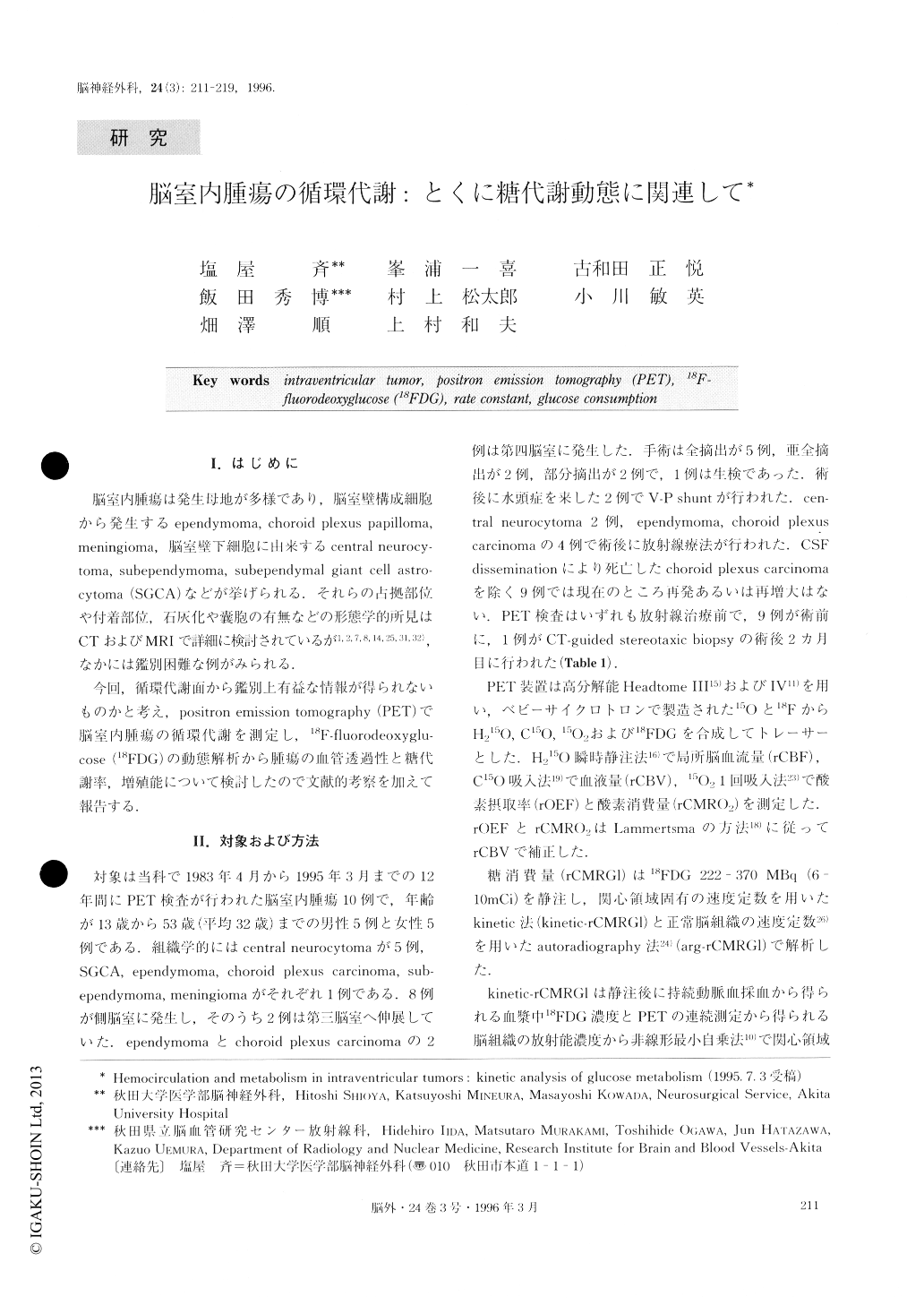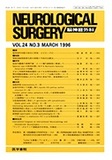Japanese
English
- 有料閲覧
- Abstract 文献概要
- 1ページ目 Look Inside
I.はじめに
脳室内腫瘍は発生母地が多様であり,脳室壁構成細胞から発生するependymoma,choroid plexus papitloma,meningioma,脳室壁下細胞に由来するcentral neurocy—toma,subependymoma,subependymal giant cell astro—cytoma(SGCA)などが挙げられる.それらの占拠部位や付着部位,石灰化や嚢胞の有無などの形態学的所見はCTおよびMRIで詳細に検討されているが1,2,7,8,14,25,31,32).なかには鑑別因難な例がみられる.
今回,循環代謝面から鑑別上有益な情報が得られないものかと考え,positron emission tomography(PET)で脳室内腫瘍の循環代謝を測定し18F-fluorodeoxyglu—cose(18FDG)の動態解析から腫瘍の血管透過性と糖代謝率,増殖能について検討したので文献的考察を加えて報告する.
To estimate hemocirculation and proliferating activ-ity of intraventricular tumor, we measured kinetic rate constants (k1*, k2*, k3*) and glucose metabolic rate (kinetic-rCMRGl) using dynamic positron emission tomography (PET), as well as regional cerebral blood flow (rCBF), blood volume (rCBV), oxygen extraction fraction (rOEF), oxygen metabolic rate (rCMRO2) and autoradiographic rCMRGI (arg-rCMRGI), in patients with intraventricular tumor.
The subjects included ten patients, five males and five females, aged from 13 to 53 years with a mean age of 32 years old. Eight tumors were located in the lateral ventricle and two extended into the third ventricle through the foramen of Monro. Another two tumors were located in the fourth ventricle. Histological dia-gnosis was as follows: five cases of central neurocyto-ma, one subependymal giant cell astrocytoma, one ependymoma, one choroid plexus carcinoma, one sub-ependymoma, and one meningioma. Tumor lesion on the PET images was determined using CT or MRI, which was performed at levels equivalent to those for the PET scans. For quantitative analysis, regions of in-terest (ROI) on PET images were delineated on the tumor and the contralateral gray matter. Hemocirculation (rCBF, rCBV) of the tumor was similar to or higher than that of the contralateral gray matter, which corresponded to neuroradiological find-ings of abundant tumor vessels. Oxygen metabolic pa-rameters (rOEF, rCMRO2) were significantly lower than those of the contralateral gray matter. Especially, low rOEF resulted in an excessive blood flow beyond oxygen demand of the tumor. The raised metabolic rate (rCMRO2/rCMRGl), as compared with that of menin-giomas or malignant gliomas, suggested aerobic gly-colysis.
The kinetic rate constants of tracer transport from blood to brain (k1*) , reverse transport from brain to blood (k2*), and phosphorylation (k3*) were analyzed according to the three-compartment model of 18F-fluo-rodeoxyglucose(188FDG). Tumor k* and k2* values were similar to or higher than those of the contralateral gray matter, suggesting high permeability due to lack of blood-brain barrier and an abundant blood supply. Tumor k3* value, an indicator of hexokinase activity, and kinetic-rCMRGl were lower in six of eight patients. These six patients have been free from tumor recur-rence or regrowth, postoperatively. In the other two pa-tients, tumor kinetic-rCMRGl was similar to or higher than that of the contralateral gray matter, suggesting high activity of proliferation. However, one patient re-ceived irradiation and has been followed up, and the other received total resection and has shown no recur-rence.
Functional information concerning intraventricular tumor is obtained by PET analysis, and kinetic analysis of the rate constants is useful for interpreting a detailed metabolic process of glucose, and provides additional information on intraventricular tumor aggressiveness.

Copyright © 1996, Igaku-Shoin Ltd. All rights reserved.


